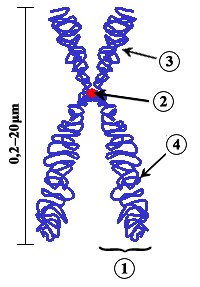Chromosome regions
This article has multiple issues. Please help improve it or discuss these issues on the talk page. (Learn how and when to remove these template messages)
|


Several chromosome regions have been defined by convenience in order to talk about gene loci. Most important is the distinction between chromosome region p and chromosome region q. The p region is represented in the shorter arm of the chromosome (p is for petit, French for small) while the q region is in the larger arm (chosen as next letter in alphabet after p).[1] These are virtual regions that exist in all chromosomes.
These are listed as follows:
- Chromatids
- Arms
- Centromere
- Kinetochore
- Telomere
- Sub telomere
- satellite chromosome or trabant.
- NOR region
During cell division, the molecules that compose chromosomes (DNA and proteins) suffer a condensation process (called the chromatin reticulum condensation) that forms a compact and small complex called a chromatid. The complexes containing the duplicated DNA molecules, the sister chromatids,[2] are attached to each other by the centromere(where the Kinetochore assembles).
If the chromosome is a submetacentric chromosome (One arm big and the other arm small) then the centromere divides each chromosome into two regions: the smaller one, which is the p region, and the bigger one, the q region. The sister chromatids will be distributed to each daughter cell at the end of the cell division. Whereas if the chromosome is isobrachial (centromere at centre and arms of equal length), the p and q system is meaningless.
At either end of a chromosome is a telomere, a cap of DNA that protects the rest of the chromosome from damage. The telomere has repetitive junk DNA and hence any enzymatic damage will not affect the coded regions. The areas of the p and q regions close to the telomeres are the subtelomeres, or subtelomeric regions. The areas closer to the centromere are the pericentronomic regions. Finally, the interstitial regions are the parts of the p and q regions that are close to neither the centromere nor the telomeres, but are roughly in the middle of p or q.

See also
References
- ^ "Short arm of a chromosome". MedicineNet. Retrieved 2016-04-10.
- ^ "National Human Genome Research Institute (NHGRI) - Centromere". National Human Genome Research Institute (NHGRI). Retrieved 2018-11-19.
